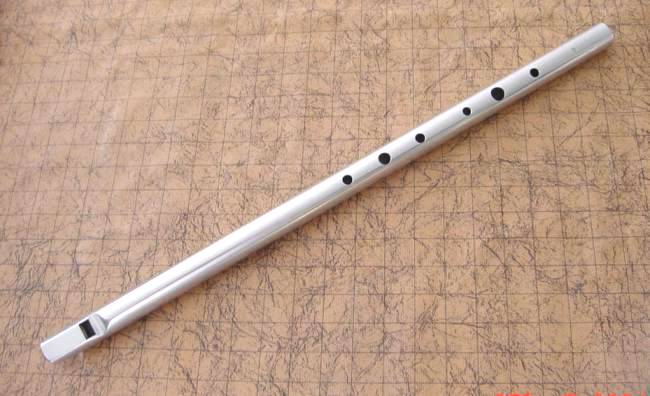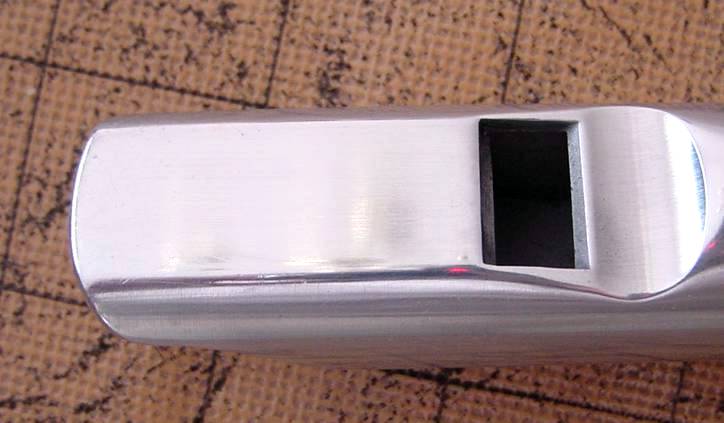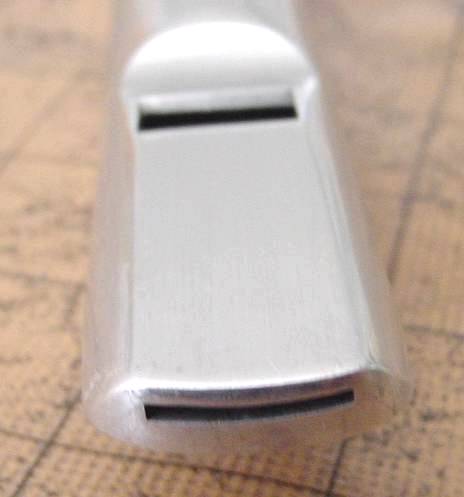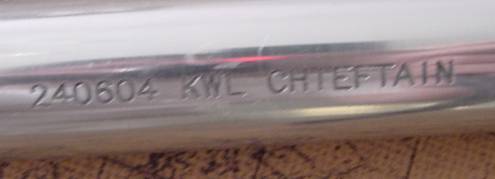Chieftain Low D, New Style Review
(Review written September 2004)
- Preface
- Last month, Phil sent me a new-style Chieftain low D to review. Woohoo! This model has a new comfort-shaped rounded mouthpiece. I'm quite fond of it. As of this writing, this shape is only experimental, and Phil doesn't know whether or not he's going to actually offer them and in what capacity yet. Since the looks are so very similar to the old one, I'll probably cut and paste a lot of the same text. But there are important differences, so keep reading!
- At a Glance
- Whistle Reviewed
- Chieftain Low D, New Style
- Models Available
- Chieftains are available tunable and non-tunable in every key imaginable. I don't think anyone produces a more complete line of instruments.
- How Acquired
- Product sample from Phil Hardy
- Construction
- Aluminum with aluminum fipple and windway.
- Price at Time of Review (in US Dollars unless otherwise noted)
- $140.00
- Available From
-
Lark in the Morning
The Whistle Shop and many more. This is not a difficult brand to acquire. You might want to be sure and ask to get the newer model though, rather than the older one, just in case.
- Appearance
- It's basically a piece of aluminum pipe with holes drilled in it. What more can I say really? And like the first one I've owned, someone has already asked me if I made it myself because, well, it looks like a piece of aluminum pipe with holes drilled in it. But this one is a bit more shiny and the moutpiece is much more sleek looking than the orignal. I'll let the pictures do the talking.
-

There she is, in all of her tube-like glory. You can kind-of see the rounded mouthpiece here. Let's get a closer look, shall we?
Here's the mouthpiece. This is the best picture I've taken of this thing..look how crisp and shiny it is. I wish I was a professional photographer, because all of the pictures deserve to look this good. Now note the rounded mouthpiece. It doesn't look like much. Phil tells me this is done by hand, and it really makes the whiste very comfortable in the mouth. It takes the corners off that otherwise take up useless space in there. I haven't clicked my teeth with this whistle..and in fact, I hardly think about it in my mouth at all. That's a testament to how one little thing can make such a big difference.Note also the labium ramp. It's much shorter than in the first chieftain I owned. So there's definitely incremental product improvments here. Subtle but important. Lets look at the mouthpiece from a different angle.

Here's a duplicate of the angle I did for the first one. Immediately, you can see that this model's a lot cleaner looking..and I don't just mean the scratches. It looks less "industrial". The lines are cleaner and more professional. The windway here is obviously a little bigger; the slight curve is an optical illusion caused by the rounded windway and photo angle. But the original design can still be recognized; it's still obivously a Chieftain.
And now, all of them are branded on the back side near the bell end. I imagine the numbers are actually the date of manufacture. which would make this one made in June 24, 2004 in this case. I also imagine KWL stands for "Kerry Whistles Ltd". No great feat of brainpower there!
- Playing Characteristics
- The whistle sounds like my first one, only better. No kidding. The first octave is mellow, still, the second octave is clear, and I haven't had any problems with shrieking. It has slightly less back pressure, but enough to keep me satisfied without me having to fight the instrument in the second octave. It's a great all-round whistle.
-
Sound clips of the whistle:
Stack of Rye
Hunter's House
Video clips of the whistle:
The Butterfly (recorded 2017)Volume: This whistle is medium-loud. It's louder than the first one, and I didn't have any problem being heard in session.
Responsiveness: This whistle is much more responsive than the first one. It's not quite as lightning fast as some of my high whistles, but I can play reels at a decent clip.
Tuning: This whistle is in tune when warmed. And it takes a lot less warming up to get in tune. The old one actually had to feel warm to be in tune. Bad, because aluminum is a good heat radiator, and so it's hard to keep it holding all that heat. I would literally sit on the old one or tuck it in my shirt next to my chest to keep it warmed up. The new one is warmed up after pushing a couple of lungfulls of air through the mouthpiece..much better! And what I said about about C-natural seems to apply to the rest of the notes, too. At the expected breath control, the tuner needle nearly freezes on the in-tune mark, but then you can push it around quite a bit; around +- 15 cents!
C-natural: OXXOOO produces an absolutely perfect c-natural on this whistle. Seriously. With the expected breath pressure, The needle moves to 0 in the middle of the tuner, and just hovers within 1-2 cents. I don't think I've ever seen a cross fingered c-natural this stable. And then, by pushing harder or softer, you can push it +- 25 cents! Usually you get stability or dynamic range in a whistle..to get both is a treat!
Hole size and placement: There are improvements here, and some potential problems. The lower D hole is no longer so far away. Now it's about where you'd hope it to be. This makes it much easier for me to play, believe me. Unfortunately, now the E hole is a bit larger than it was before. I don't personally have any problems with it, but people with especially narrow fingers might.
Air volume and pressure requirements: This whistle takes a little more air than the first one, but not much. It has much less back-pressure, making it a lot easier to hit the upper section of the second octave. A pretty easy blower.
Clogging: This whistle gets just as wet as the first one did. But amazingly, it clears itself! I have felt the condensation blow out and hit my fingers a few times when playing, and haven't had any clogging issues. While this may be a little gross to some, it's actually great! It means the whistle won't give out unexpectedly, and will require a minimum of maintenance while playing.
Wind Resistance: The only real downside to this whistle is that it's really wind-susceptible. A medium breeze across the windway cuts it out. But that's only a downside if you play outside at festivals and the like. It just means you have to do the wind dance a bit more.
- Summary
- Great low D whistle. Keeps all the good qualities of the first one, while eliminating of all the stuff I didn't like. I can't really think of anything more I could ask out of this whistle. Well, except for maybe more wind resistance. I guess you can't have it all..but this whistle really comes close!